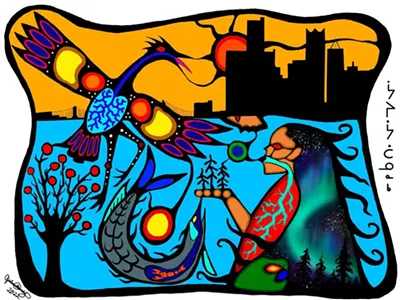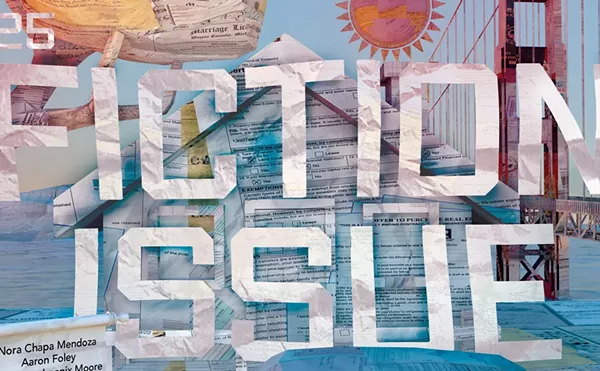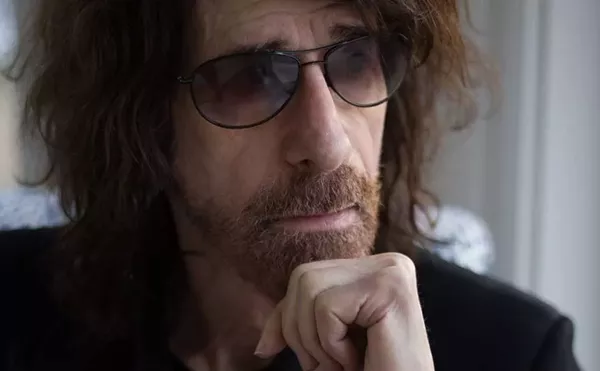
Audio By Carbonatix
[
{
"name": "GPT - Leaderboard - Inline - Content",
"component": "35519556",
"insertPoint": "5th",
"startingPoint": "3",
"requiredCountToDisplay": "3",
"maxInsertions": 100,
"adList": [
{
"adPreset": "LeaderboardInline"
}
]
}
]
December 16, 2023. My wife, Rana, and our two daughters have gathered with dozens of others in Market Square Park in Cleveland for the demonstration, our first one as a family. It’s cold and windy, the gray sky fading into dusk. A middle-aged man with a keffiyeh wrapped around his neck waves a Palestinian flag from a long, extended pole. Palestinian flags ripple in every corner of the square. I see many fellow Arab Americans, but also others who wear keffiyehs and carry signs that read: “Free Palestine” and “Ceasefire Now!” One says: “Korea Stands with Palestine.” A helicopter hovers overhead.
We recently moved to Ohio for my new job. We used to live in the Detroit metropolitan area, which has the highest concentration of Arab Americans in the country. It’s comforting to hear the sound of Arabic again among so many people.
Our daughters sit in a double stroller. Alma is three years old, Mira twenty months. They’re snuggled in their winter coats, hoodies over their heads. I remember when my father took me and my older sister to our first demonstration. It was in Washington, D.C. in the fall of 1995; I was fifteen. There were approximately fifty protesters. We marched in front of the White House, demanding an end to the Israeli occupation of Palestine. People waved Palestinian and Lebanese flags and held up signs. My father, sister, and I had come empty handed. But we chanted revolutionary slogans along with the others.
As I look over the gathering in the square, I notice a white man with a thick beard dressed as a crusader, a sword clasped to his waist. He’s in chainmail and wears a cloak with a red cross. He walks around the edges of the crowd with his hands clasped behind his back, smirking. I worry that he’s armed with a gun.
It’s been over two months since the attacks of October 7 and Israel’s continuing bombardment of Gaza. According to the Palestinian health ministry, close to twenty thousand Palestinians have been killed, the majority women and children. This number doesn’t account for all those buried under the rubble.
The Secretary General of the United Nations, António Guterres, told reporters that Gaza has become a “graveyard for children.”
It’s the children I keep thinking about the most, how innocent they are, and how they don’t deserve to live in fear or be killed. I’ve seen the haunting videos and images on social media and Arabic news outlets of children being removed from the rubble, their bodies crushed; injured children in hospitals, their heads and limbs bandaged. What horrifies me the most are the videos of children in fear — they literally tremble with fear. In one, a boy, maybe seven or eight, wearing a backpack, keeps pacing his apartment hallway, telling his parents repeatedly, “I don’t want to die. I don’t want to die.” In another, children write their names on the inside of their forearms in permanent black ink markers so that in the event they are killed, their bodies can be identified.
At home I smother Alma and Mira with kisses and hugs. When I hold them in my arms, I press them to my chest, as if I’m afraid to lose them. As if they could be killed and these are our last moments together. When they laugh, I’m filled with gratitude that they’re safe, something that I wish I could say for all the children of Gaza.
One of the organizers of the demonstration, a young man in a knitted cap, strides atop a concrete platform, grabs a mic, and chants, “Free, free Palestine!” Rana and I repeat after him, joining the chorus. Alma and Mira remain silent, taking in their surroundings. Two speakers, one a Palestinian American and the other a representative from Jewish Voice for Peace, give speeches. I keep watch for the crusader. I spot him across the square, his hands still clasped behind his back.
The organizer in the knitted cap takes back the mic and shouts, “Free, free Palestine!”
This time, Alma repeats after him. Mira doesn’t react. Mira’s only words are “Mama,” “Baba,” and “Ma” for “Alma.”
The sky darkens and streetlights turn on. The plan is to march to Rocket Mortgage FieldHouse, which is home to the Cleveland Cavaliers. The demonstration organizers place baby-like dummies wrapped in white sheets stained with fake blood on the platform and ask for volunteers to carry them.
We leave Market Square Park, cross Hope Memorial Bridge, take a left on Ontario Avenue, and arrive at the stadium. We are escorted by a caravan of police cars. As we chant a protester beats on her drum in the back of the procession. Every now and then, I hear Alma’s soft voice as she makes the call for freedom. Mira is sound asleep.
Outside the stadium, we listen to more speeches, and then retrace our steps. The crusader stalks us the entire time.
In the weeks that follow, as Alma plays with her toys, I occasionally hear her say, “Free, free Palestine.” She says it not as a chant, but as a melodious line to a song.
*
Four months later. Half a year of unspeakable horror. More than thirty-four thousand Palestinians have been killed. Most Gazans have been displaced and are surviving in appalling conditions. The Israeli blockade on humanitarian aid is starving children to death. Famine is imminent. The other night I woke up from a nightmare: I was tasked with caring for my cousin’s newborn baby boy; when I held him, his body was cold and limp.
One afternoon in March, on a walk in the town square where we live, Rana and our daughters come across a group of college students chanting, “Free, free Palestine.” Alma is now three and seven months old. Mira is just over two.
Later that day, at home, Mira says, “Fee, fee tine.”
Ghassan Zeineddine is the author of the story collection Dearborn and co-author of the creative nonfiction anthology, Hadha Baladuna: Arab American Narratives of Boundary and Belonging.
Part of our 2024 Fiction Issue.





